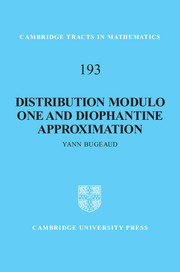Book contents
- Frontmatter
- Contents
- Preface
- Frequently used notation
- 1 Distribution modulo one
- 2 On the fractional parts of powers of real numbers
- 3 On the fractional parts of powers of algebraic numbers
- 4 Normal numbers
- 5 Further explicit constructions of normal and non-normal numbers
- 6 Normality to different bases
- 7 Diophantine approximation and digital properties
- 8 Digital expansion of algebraic numbers
- 9 Continued fraction expansions and β-expansions
- 10 Conjectures and open questions
- Appendix A Combinatorics on words
- Appendix B Some elementary lemmata
- Appendix C Measure theory
- Appendix D Continued fractions
- Appendix E Diophantine approximation
- Appendix F Recurrence sequences
- References
- Index
6 - Normality to different bases
Published online by Cambridge University Press: 05 October 2012
- Frontmatter
- Contents
- Preface
- Frequently used notation
- 1 Distribution modulo one
- 2 On the fractional parts of powers of real numbers
- 3 On the fractional parts of powers of algebraic numbers
- 4 Normal numbers
- 5 Further explicit constructions of normal and non-normal numbers
- 6 Normality to different bases
- 7 Diophantine approximation and digital properties
- 8 Digital expansion of algebraic numbers
- 9 Continued fraction expansions and β-expansions
- 10 Conjectures and open questions
- Appendix A Combinatorics on words
- Appendix B Some elementary lemmata
- Appendix C Measure theory
- Appendix D Continued fractions
- Appendix E Diophantine approximation
- Appendix F Recurrence sequences
- References
- Index
Summary
Keeping in mind that almost all real numbers are normal to every integer base, we investigate the following question: Do there exist real numbers which are normal to one base r, but not normal to another base s? By Theorem 4.4 we know already that the answer is negative when r and s are multiplicatively dependent. However, at the end of the 1950s, Cassels and W. M. Schmidt, independently, gave a positive answer to this question when r and s are multiplicatively independent. Section 6.1 is devoted to their result. In the second section, we discuss its extension to non-integer bases. Then, we investigate what can be said on the expansions of a given number to two different bases. The final section is concerned with the study of the analogous question for representations of integers in two different bases.
Normality to a prescribed set of integer bases
Theorem 4.4, established by Maxfield [494], asserts that if r and s are multiplicatively dependent integers at least equal to 2, then a real number is normal to base r if, and only if, it is normal to base s. However, this result says nothing if r and s are multiplicatively independent. In ‘The new Scottish book’ (Problem 144), Steinhaus [663] asked whether normality with respect to infinitely many bases implies normality with respect to all other bases. Answers have been given independently by Cassels [182] and W. M. Schmidt [627]. Below is the statement established by Schmidt.
- Type
- Chapter
- Information
- Distribution Modulo One and Diophantine Approximation , pp. 118 - 138Publisher: Cambridge University PressPrint publication year: 2012



